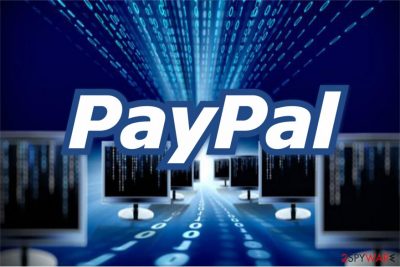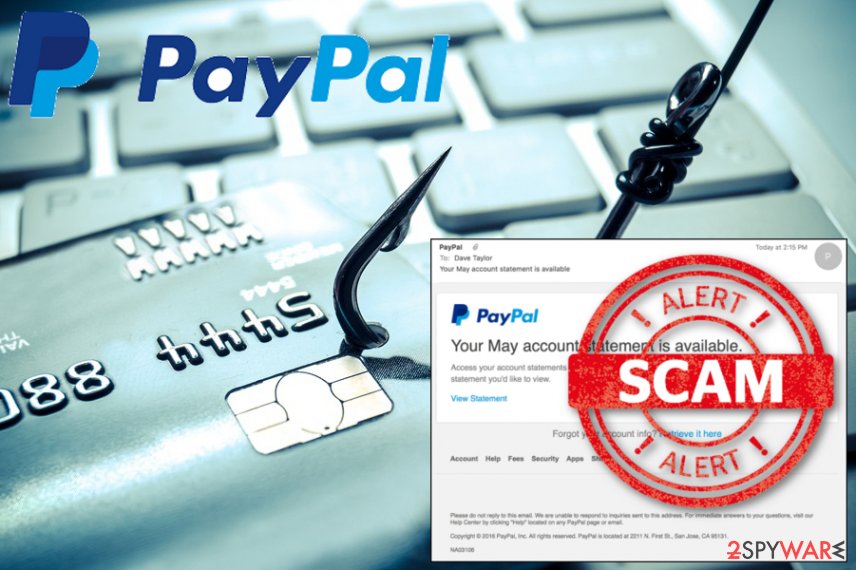PayPal virus (Virus Removal Guide) - updated Jan 2019
PayPal virus Removal Guide
What is PayPal virus?
PayPal virus is a phishing campaign when scammers hide the malicious purpose behind a safe-looking email message

PayPal virus is a scam which is designed to stealthily infect systems with malware or trick users into revealing their credentials[1]. When seeking these aims, hackers spread cleverly-written emails that contain infected attachments. After being downloaded to the system, the attachment, which typically hides malware's executable, launches it in the background and it becomes active. PayPal trojan malware was first spotted back in 2013 with its first attempts at tricking people. Since then these scam and phishing campaigns appear more and more developed and luring.[2] Recently, this virus targeted people using the social media platform Twitter.[3] During the Christmas time, account purported to be a legitimate PayPal Twitter promoted the event with a lottery. All those techniques used by this trojan aim to scam people and collect their credentials for the later use.
| Name | PayPal virus |
|---|---|
| Type | Trojan horse |
| Category | Malware |
| Active since | 2013 |
| Working principle | Tricks people into revealing their information. Uses legitimate-looking PayPal messages |
| Recent activity | PayPal phishing campaign at the end of 2018 |
| Distribution | |
| Elimination | Use reputable anti-malware tool to clean the system thoroughly and remove PayPal virus. Fix virus damage using FortectIntego |
Typically, Paypal scam tricks users into downloading infected files because they are named under the names of well-known companies, useful documents or legitimate computer components that are said to be missing. When inside the system, PayPal virus is used to perform the following actions:
- Spy on your online activity;
- Copy and send information from your PC to the criminals;
- Open backdoors to help other high-risk threats infiltrate the system;
- Link the victim to a fake bank website or email page and steal login information;
- Download updates of malware which is already present on your system.
PayPal virus can imitate an innocent email message or software while, in reality, it might monitor your browsing experience and track your frequently visited pages. Once it detects which social media platforms you use, it can create a fraudulent window asking you to sign in. Note that the pop-up may look extremely genuine and may use https which is supposed to be a sign of the safe site. Likewise, many people get deceived and submit their private information, such as log-in names and passwords.
PayPal virus scamming message may state about the account issues or fake porchases and read the following:
Sender: Pay Pal
Topic: Unusual sign-in activityWe detected something unusual about a recent sign-in to the PayPaI account ..Sign-in detailsCountry/region: HondurasIP address: 104.184.29.77Date: 5/25/2018Platform: iOSBrowser: SafariPlease go to your recent activity page to let us know whether or not this was you. If this wasn’t you, we’ll help you secure your account. If this was you, we’ll trust similar activity in the future.Review recent activityTo opt out or change where you receive security notifications, click here.
Thanks,
Another way how the developers of Paypal phishing scam try to lure people into giving their credentials is by stating that their accounts are temporarily suspended, and they need to confirm their identity with a photograph. The victims are asked to submit pictures of themselves holding their ID and credit cards to PayPal phishing site which imitates official online payment page.
This virus endangers not only your computer but privacy as well. Therefore we encourage you to remove PayPal scam as soon as possible. You can do that by using FortectIntego or another powerful security software. Additionally, we want to remind you not to try to get rid of it by yourself. Elimination procedure requires an experienced IT expert or a trojan removal software. Thus, any attempts to delete malicious files might lead to further damage.
PayPal phishing scam during Holidays of 2018
During the busiest time of the year malware creators also keep on working because people tend to shop online, buy last-minute gifts or skip through websites paying less than enough attention. Phishing scams are nothing news and Holiday is the best time to fall for reward or gift scam online.
A Twitter account called PayPalChristm promoted the event that you can win valuable prizes and you only need to login to your account. However, this fake account redirected to phishing link that encourages to enter your credentials and verify the account. Unfortunately, when you do so you are not winning any Maserati or an iPhone.
Scammers focus on getting your information and confirmed details go to the malicious server and get collected by these cybercriminals behind PayPal virus that are interested in accessing your account and exploiting the victim financially later on.

Note that PayPal virus might appear as a scam message on suspicious pages as well like FBI PayPal virus which is considered to be an offspring of the mother program. Criminals try to convince credulous people by disguising as FBI law enforcement agency. The pop-up claims that your computer is blocked due to one of the following reasons:
- Violating Copyright laws by downloading music, films or video files illegally;
- Distributing adult-only content which is related to child abuse.
PayPal scam pop-up says that you have to pay a fine which might vary from $200 to $500. At this point, we assure you that this is only an attempt to swindle money from you. You should never transfer funds to the criminals since there are alternative ways to unlock your computer. Be aware that sometimes it is not even locked. Therefore, closing the tab/window should help.
However, Trojan horse can be infiltrated via clicks on any malware-laden content online[4]. Thus, we recommend scanning your system with a professional antivirus tool to initiate PayPal virus removal if needed. Once again, do not try to uninstall malware-related files by yourself since you can harm your system.

Fake e-mails with known company names distribute malware directly to your device
Experts from LosVirus.es[5] spotted that hackers employ several methods to spread this dangerous Trojan. However, most of its versions are delivered via spam emails which urges to click on the malicious link or attachment to fix the PayPal-related problem.
One of the most recent ones detected contains a message which states the following:
Our system detected unusual charges to a credit card linked to your PayPal account.
Reference Number: PP-259-187-991
This is the Last reminder to log in to PayPal as soon as possible.
Once you log in, you will be provided with steps to restore your account access.Click here to activate your account
Once the victim clicks on the compromised link, he or she triggers an automatic installation of the malware. Since Trojan horses have the ability to disguise under legitimate processes or software, the user might not even recognize that they manually infect their computers.
Note that those fake emails are designed to look convincing and legitimate. They might include such parts as “To unblock your account you must complete these steps” or “Click on the link to fix the problem.” As mentioned above, you should never click on any suspicious attachments or links despite the fact that they might look genuine.
Additionally, if you have any doubts that this email could be legitimate, we recommend contacting PayPal and asking about the letter before you click the link or download the attachment. We also advise using powerful security software at all times to make sure that your computer is protected.
Remove Paypal virus and get back to the safe machine
Trojan horses and other malware that are spread using Paypal scams are dangerous computer threats that can hardly be removed without additional software. It is impossible to remove PayPal virus manually because you can't guess the name of the virus (there is a wide list of viruses that have been spread with its help) or its location.
However, you can always employ a professional antivirus program to detect and eliminate the malware for you. This method is also considered to be the safest way to get rid of any kind of virus hiding on your computer. Keep in mind that trojans can open backdoors to help ransomware or other dangerous infections infiltrate your computer without any sign.
Therefore, if you encounter PayPal scam pop-up or the redirect to a phishing site, you should never pay the demanded amount of money or submit your personal details. Ignore all claims about the FBI fines or errors which might occur on your account. Remember, hackers might employ creative ways to swindle money or other valuable information from gullible people.
Additionally, the presence of the malware can be recognized by a significant decrease in computer's performance. Likewise, if you have noticed that your PC is acting sluggish, programs crash and loads for an extensive period of time, your system might be corrupted by a trojan.
In this case, you should download FortectIntego, SpyHunter 5Combo Cleaner, or Malwarebytes to examine your files and start PayPal virus removal. These programs are specifically designed to deal with various cyber threats and maintain PC security in the future. We promise that it won't take long before you will be able to use the trojan-free computer again. Thus, do not hesitate and check your system if you have any doubts.
Getting rid of PayPal virus. Follow these steps
Manual removal using Safe Mode
You can get rid of this Trojan by rebooting the device in Safe Mode with Networking and then using the antivirus program:
Important! →
Manual removal guide might be too complicated for regular computer users. It requires advanced IT knowledge to be performed correctly (if vital system files are removed or damaged, it might result in full Windows compromise), and it also might take hours to complete. Therefore, we highly advise using the automatic method provided above instead.
Step 1. Access Safe Mode with Networking
Manual malware removal should be best performed in the Safe Mode environment.
Windows 7 / Vista / XP
- Click Start > Shutdown > Restart > OK.
- When your computer becomes active, start pressing F8 button (if that does not work, try F2, F12, Del, etc. – it all depends on your motherboard model) multiple times until you see the Advanced Boot Options window.
- Select Safe Mode with Networking from the list.

Windows 10 / Windows 8
- Right-click on Start button and select Settings.

- Scroll down to pick Update & Security.

- On the left side of the window, pick Recovery.
- Now scroll down to find Advanced Startup section.
- Click Restart now.

- Select Troubleshoot.

- Go to Advanced options.

- Select Startup Settings.

- Press Restart.
- Now press 5 or click 5) Enable Safe Mode with Networking.

Step 2. Shut down suspicious processes
Windows Task Manager is a useful tool that shows all the processes running in the background. If malware is running a process, you need to shut it down:
- Press Ctrl + Shift + Esc on your keyboard to open Windows Task Manager.
- Click on More details.

- Scroll down to Background processes section, and look for anything suspicious.
- Right-click and select Open file location.

- Go back to the process, right-click and pick End Task.

- Delete the contents of the malicious folder.
Step 3. Check program Startup
- Press Ctrl + Shift + Esc on your keyboard to open Windows Task Manager.
- Go to Startup tab.
- Right-click on the suspicious program and pick Disable.

Step 4. Delete virus files
Malware-related files can be found in various places within your computer. Here are instructions that could help you find them:
- Type in Disk Cleanup in Windows search and press Enter.

- Select the drive you want to clean (C: is your main drive by default and is likely to be the one that has malicious files in).
- Scroll through the Files to delete list and select the following:
Temporary Internet Files
Downloads
Recycle Bin
Temporary files - Pick Clean up system files.

- You can also look for other malicious files hidden in the following folders (type these entries in Windows Search and press Enter):
%AppData%
%LocalAppData%
%ProgramData%
%WinDir%
After you are finished, reboot the PC in normal mode.
Remove PayPal using System Restore
Employ System Restore feature and restore the system in the previous state:
-
Step 1: Reboot your computer to Safe Mode with Command Prompt
Windows 7 / Vista / XP- Click Start → Shutdown → Restart → OK.
- When your computer becomes active, start pressing F8 multiple times until you see the Advanced Boot Options window.
-
Select Command Prompt from the list

Windows 10 / Windows 8- Press the Power button at the Windows login screen. Now press and hold Shift, which is on your keyboard, and click Restart..
- Now select Troubleshoot → Advanced options → Startup Settings and finally press Restart.
-
Once your computer becomes active, select Enable Safe Mode with Command Prompt in Startup Settings window.

-
Step 2: Restore your system files and settings
-
Once the Command Prompt window shows up, enter cd restore and click Enter.

-
Now type rstrui.exe and press Enter again..

-
When a new window shows up, click Next and select your restore point that is prior the infiltration of PayPal. After doing that, click Next.


-
Now click Yes to start system restore.

-
Once the Command Prompt window shows up, enter cd restore and click Enter.
Finally, you should always think about the protection of crypto-ransomwares. In order to protect your computer from PayPal and other ransomwares, use a reputable anti-spyware, such as FortectIntego, SpyHunter 5Combo Cleaner or Malwarebytes
How to prevent from getting trojans
Protect your privacy – employ a VPN
There are several ways how to make your online time more private – you can access an incognito tab. However, there is no secret that even in this mode, you are tracked for advertising purposes. There is a way to add an extra layer of protection and create a completely anonymous web browsing practice with the help of Private Internet Access VPN. This software reroutes traffic through different servers, thus leaving your IP address and geolocation in disguise. Besides, it is based on a strict no-log policy, meaning that no data will be recorded, leaked, and available for both first and third parties. The combination of a secure web browser and Private Internet Access VPN will let you browse the Internet without a feeling of being spied or targeted by criminals.
No backups? No problem. Use a data recovery tool
If you wonder how data loss can occur, you should not look any further for answers – human errors, malware attacks, hardware failures, power cuts, natural disasters, or even simple negligence. In some cases, lost files are extremely important, and many straight out panic when such an unfortunate course of events happen. Due to this, you should always ensure that you prepare proper data backups on a regular basis.
If you were caught by surprise and did not have any backups to restore your files from, not everything is lost. Data Recovery Pro is one of the leading file recovery solutions you can find on the market – it is likely to restore even lost emails or data located on an external device.
- ^ Jordan Gaither. The Effects of the Trojan Horse Virus. Techwalla. Tech & Gadget Reviews, Metascores.
- ^ Will Yakowicz. The 3 Biggest Phishing Scams of 2018. Inc. Advices for your business.
- ^ Catie Keck. Phishing Scam From Fake PayPal Account Was Promoted on Twitter. Gizmodo. We come from the future.
- ^ Malvertising. When Online Ads Attack. Trend Micro. Enterprise Cyber Security Solutions.
- ^ LosVirus. LosVirus. Security and Spyware News.





















